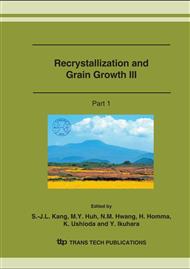p.533
p.539
p.545
p.551
p.557
p.563
p.569
p.575
p.581
Formation of Ultrafine Grained Ferrite by Warm Deformation of Tempered Lath Martensite in Low Alloy Steels
Abstract:
Microstructure change during warm deformation of tempered lath martensite in Fe-2mass%Mn-C alloys with different carbon contents in the range between 0.1 and 0.8mass%C was investigated. Specimens of the alloys after being quenched and tempered at 923K for 0.3ks were compressed by 50% with a strain rate varying from 10-3 to 10-4s-1 at 923K. EBSD analysis of the deformed microstructures has revealed that fine equiaxed ferrite (α) grains surrounded by high-angle boundaries are formed by dynamic recrystallization (DRX). As carbon content increases, the DRX α grain size decreases. This could be attributed to the change in volume fraction of the cementite (θ) phase as boundary dragging particles. The sub-micron θ particles can suppress the coarsening of the DRX α grains by exerting a pinning effect on grain boundary migration. Furthermore, the fraction of recrystallized region increases by increasing carbon content, presumably due to a decrease in the martensite block width as an initial α grain size and a larger volume fraction of hard second phase (θ) particles. Both of these should increase inhomogeneous plastic deformation which promotes the recrystallization. It seems that continuous DRX is responsible for the formation of ultrafine α grains in the tempered lath martensite.
Info:
Periodical:
Pages:
557-562
Citation:
Online since:
October 2007
Price:
Сopyright:
© 2007 Trans Tech Publications Ltd. All Rights Reserved
Share:
Citation:


